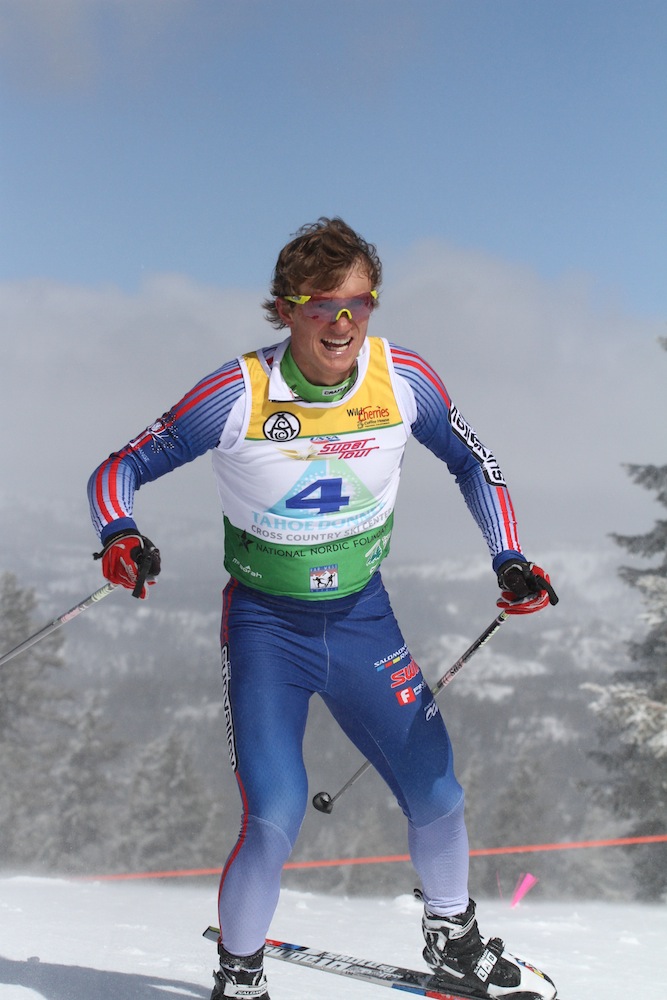
DAVOS, Switzerland – If you’re a U.S. or Canadian ski fan, you’ve seen it before. An athlete has a great season, wins the SuperTour or NorAm circuit, and earns the privilege of racing on the World Cup for the first period of the next season, courtesy of the International Ski Federation.
But they get there and they can’t quite replicate the performances that earned them the spot in the first place. In the beginning of both 2012 and 2013, Canada’s Alysson Marshall struggled mightily in distance racing in Gällivare, Sweden, and Kuusamo, Finland, although she nearly qualified for sprint quarterfinals in Kuusamo.
Last year, Marshall’s teammate Kevin Sandau and American Sylvan Ellefson were mired in the 70’s and 80’s in early-season starts. In 2011, Chris Cook was hovering at the back of the results page. Yet these were the fastest domestic racers in North America – what was going on?
Jumping straight onto the World Cup circuit at the beginning of the season can be hard, says Mikey Sinnot, a Sun Valley Gold Team skier who won the U.S. SuperTour last season and has been traveling with the World Cup so far this fall.
It’s not the first time he has competed on skiing’s highest circuit – he did a stint in the middle of the 2012 season, as well as earning starts when the tour visited Canada in 2008, 2009, and last December. But the early season races are a bit different than what he has seen before.
“It’s hard because the field is so tough,” Sinnott said after placing 85th in the 1.5 k freestyle sprint on Sunday. “It’s a lot bigger fields, a lot deeper fields [than in the middle of the season]. There’s a lot of Norwegians and Finns fighting for spots, and they’re all primed and ready to go.”
Of course, there can be advantages, too. Do well enough and you might be able earn your keep on the circuit and continue traveling with the national team, as U.S. skier Holly Brooks did a few years ago. At this point, that’s the model top domestic racers would like to follow.
And knowing that you’re heading straight for the toughest competition there is can allow you to design your off-season training plan accordingly.
“It’s also easier in some ways because you can prepare yourself, and make yourself in top fitness, also,” Sinnott said. “Which I didn’t do.”
Not one to complain too much, Sinnott took the blame for his performances so far this season: 93rd in the opening Kuusamo mini-tour, 81st in the 15 k classic in Lillehammer, Norway, and then the relay here.
“My form is so poor,” he said. “… I’ve been skiing pretty terribly. Distance races have been murder. I thought that going up those climbs, that the 30 k [on Saturday, which he sat out] would just bury me even worse. It didn’t seem like it was important, so I might as well try for the sprint and have better success.”
After being on the cusp of becoming a regular World Cup skier for several seasons – he’s usually at or near the top of the SuperTour rankings – Sinnott is looking at the big picture. This year, that means the Olympics. Things will likely have to turn around if he is going to snag a trip to Sochi; after the coming weekend of racing in Asiago, Italy, he will return to the U.S. to prepare for national championships.
“It’s not ideal,” Sinnott said of whether the World Cup is preparing him to win back home. “I’ve been battling with the idea of going back versus staying here, especially since my form is so poor. But I kind of thought that these opportunities don’t come around that often.”
And the big picture, too, means understanding what results he might have at the Olympics. At 28 years old, Sinnott doesn’t want to just punch his ticket as a tourist – he wants to punch it as a contender. Starting off the season in Europe was a way to see whether that would be possible.
“I want to prove myself against the best,” he said. “If I make the Olympics, I don’t want to do it just because I got good points back in the U.S. I want to do it because I’ve showed that I can compete with the best in the world. And I can’t do that at home, I have to do it here. And if I can’t do it here, then I don’t deserve the Olympics.”
While he was honest, and self-effacing, about his skiing so far this year, Sinnott certainly isn’t counting himself out in the Olympic selection process.
“I kind of have an idea in my head [of what he has to do to make it],” Sinnott said.
Despite spending the last few weeks traveling with the U.S. Ski Team, that hasn’t given him an advantage in terms of Olympic qualifying, which Sinnott said is just as it should be.
“There’s criteria, and then there’s subjective choices,” he explained. “I feel like you have to do something special [to get that]. And they can’t say what subjective criteria it is, because then it’s not subjective… It kind of depends on who does what. Maybe I’ll do something great, but Dakota [Blackhorse von Jess] can rock something better.
“And then that’s it.”
Chelsea Little
Chelsea Little is FasterSkier's Editor-At-Large. A former racer at Ford Sayre, Dartmouth College and the Craftsbury Green Racing Project, she is a PhD candidate in aquatic ecology in the @Altermatt_lab at Eawag, the Swiss Federal Institute of Aquatic Science and Technology in Zurich, Switzerland. You can follow her on twitter @ChelskiLittle.




One comment
T.Eastman
December 17, 2013 at 9:01 pm
Keep going, like Austin Powers, your mojo will return…
… yea, baby!